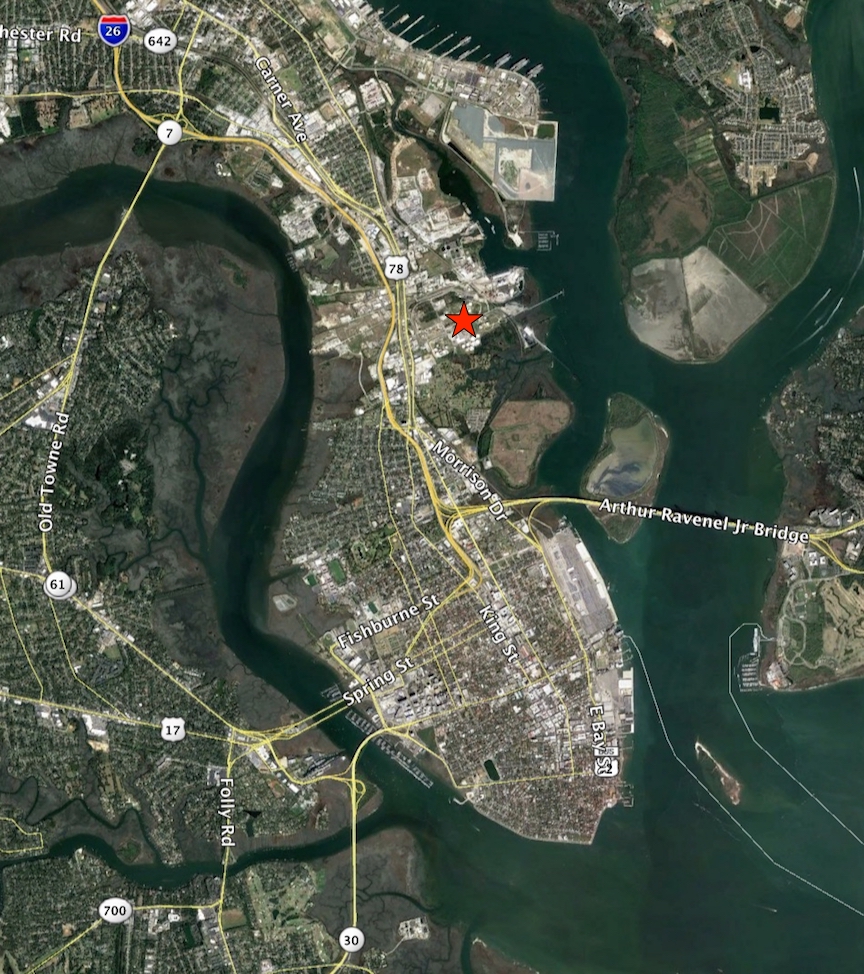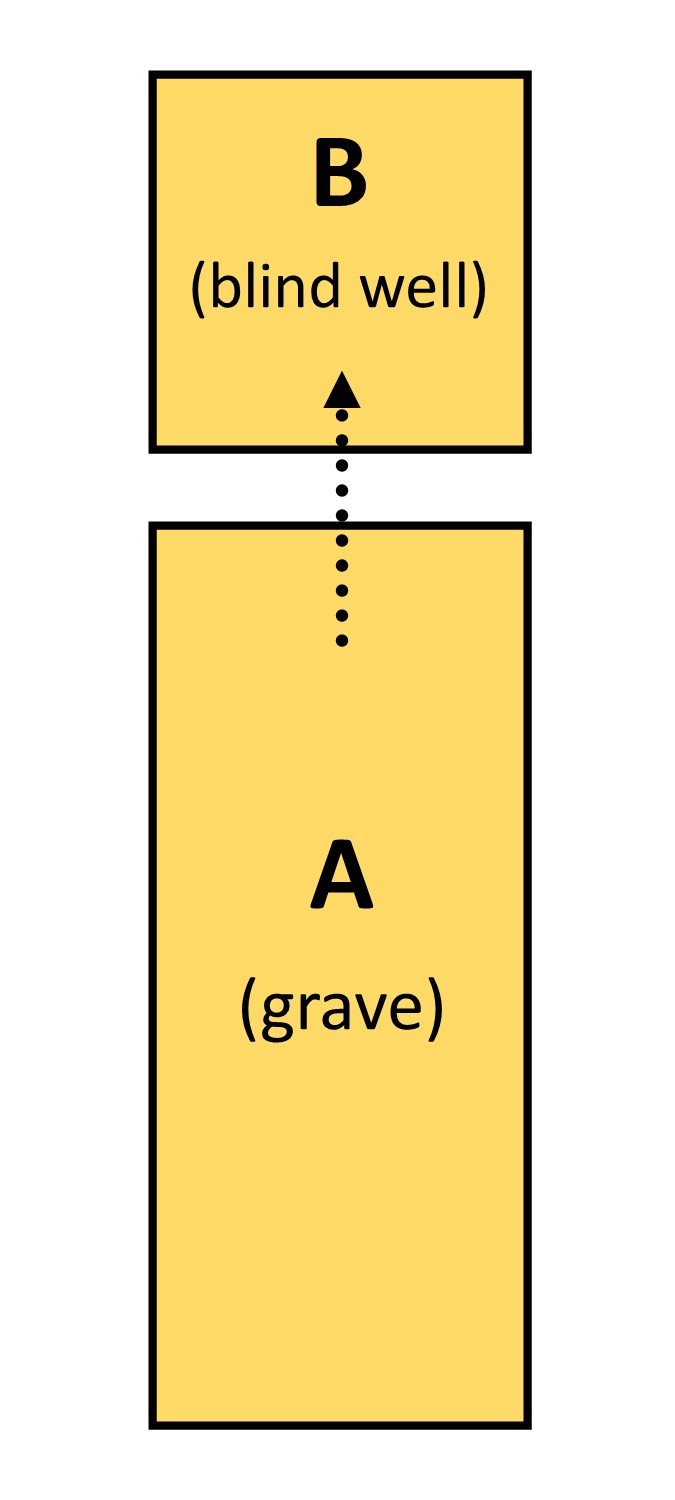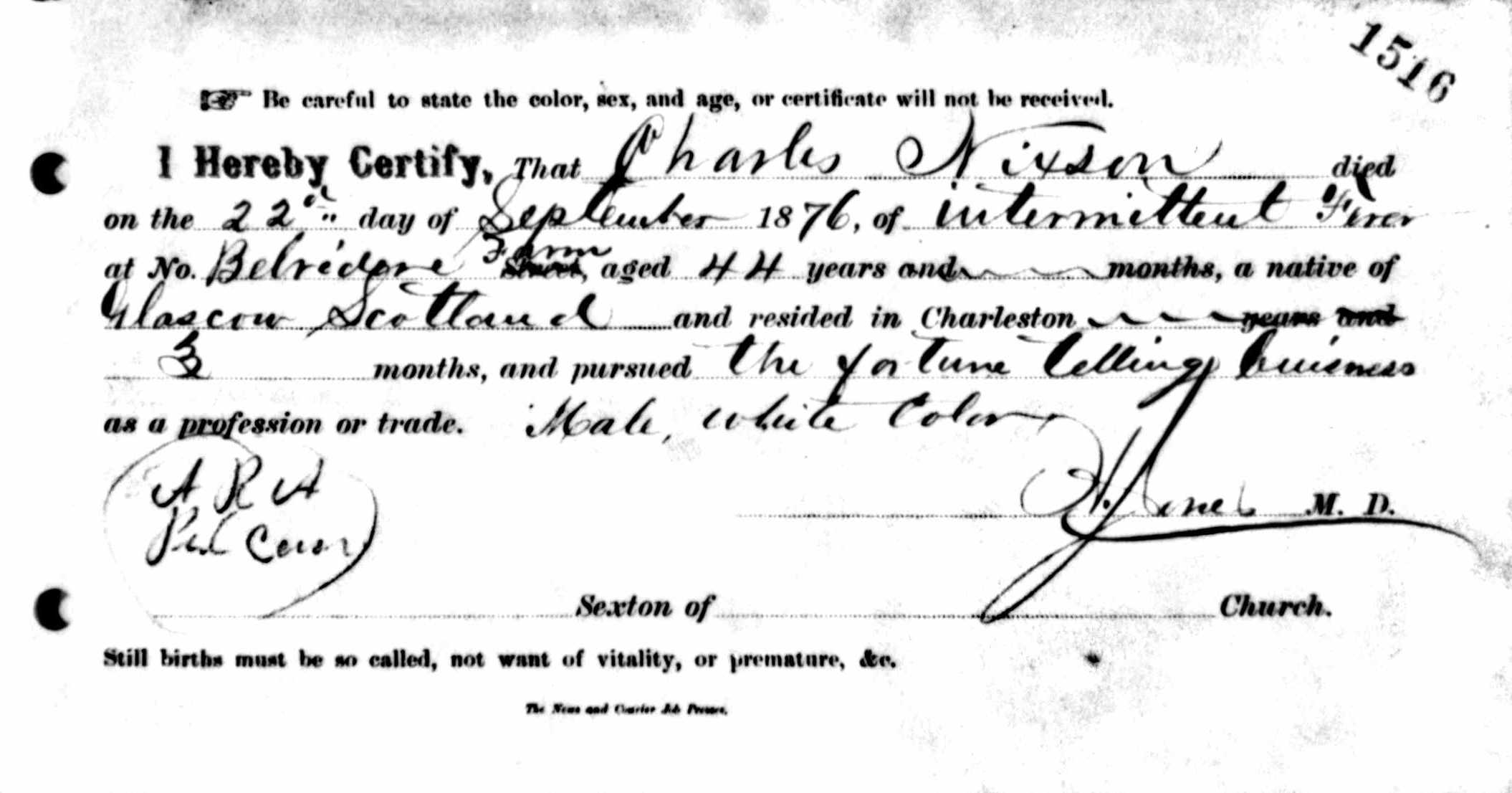
After last week’s cliffhanger, we now return to the story of Charles Barker Nixon, a traveling magician and escape artist who came to Charleston in 1876 to be buried alive for the amusement of a crowd of spectators. This week we’ll witness his rise from the grave, learn how the feat was accomplished, and hear the pathetic conclusion to the story of Professor Nixon, the strange enchanter who brought mystery and excitement to the Lowcountry during the dark days of Reconstruction violence in the summer of ‘76.
Late in the afternoon of Monday, August 28th, 1876, a crowd of about five hundred men, women, and children came to Belvidere farm, on the neck of the Charleston peninsula, to witness Professor Nixon’s mysterious spectacle. The incredulous crowd was allowed to inspect the grave and the coffin before the performance, and many who viewed the scene expressed doubts that Nixon would ever allow himself to be placed inside the coffin and lowered into the earth. Shortly after five p.m., the professor began shouting at the crowd in an effort to herd the multitude onto a viewing platform erected about fifty feet away from the grave, but the mass of curious spectators resisted this effort. They wanted to stand as close as possible to the grave site, to see with their own eyes that he was truly inside the pine box as it was lowered into the grave. After several minutes of pleading and commanding in vain, an exasperated Nixon simply walked to the viewing platform, and the bulk of the crowd followed in his wake. There the self-described Egyptian prophet commenced a speech, at first imploring the citizens to maintain order, and then setting the tone for the upcoming spectacle. Since the entire event was described in colorful detail by an intrepid reporter from the Charleston New and Courier, I’ll let that eye-witness narrate the rest of the story:
“Then [Professor Nixon] mounted a stand and made a speech. . . . ‘Now I am not going to rob you or steal from you. I want you to see my trick and see what you think of it. . . . I am going to do what I promised to do. You have had from [August] the 18th to the 28th to examine everything and see if there are any air-pipes or air-pumps about the grave or coffin. I tell you now there are none. But there is a little more at the bottom of this trick which you may learn before I get through with it [emphasis original].’
After this startling announcement the prophet proceeded to deliver a learned disquisition of the laws of God and man, advising all his mourners to obey both. ‘In the meantime, he exclaimed, ‘in order to occupy your time until more people arrive, I will give you a few of my tricks.’ [Apparently Nixon was expecting a much larger crowd to pay admission to the event, so he decided to kill time.] Then the professor trotted out his [magic interlocking] rings and went through a performance with them. During this performance a Milesian gentleman [that is, an Irishman,] who had been imbibing pretty freely seemed to be anxious for the wake to proceed, and intimated as much in terms of unmistakable severity. Some of the boys too began to suspect that he wouldn’t be buried after all. They were determined, however, not to be done out of the funeral, and intimated in pretty plain language, garnished by strong adjectives, that if he didn’t go through with the performance himself they would take the matter into their own hands and bury him anyhow. But the prophet went on with his rings until nearly half-past 5 o’clock, when he yielded to the impatience of the crowd and descended to make Preparations for the Funeral.
Nine gentlemen were selected to act as judges and see that he had a fair burial, and that there was no deception about it. The prophet’s original plan was to have the multitude stand off [about fifty feet away on a platform] and let the nine judges see that he was put in the coffin, screwed in and buried. But the crowd wouldn’t stand this kind of arrangement. They hooted it[.] One gentleman stepped out and swore by the beard of Mahomet [sic] and the bones of Methusela [sic] that he would see it all for himself or have his money back. He was added to the committee of judges. Another followed suit, and it was found impossible to go on. So a ring was made around the coffin, which lay on the ground about ten feet from the grave. In it was a box of Mason’s blacking [that is, a small shoe shine box, which contained], two [glass] phials, one containing a white and one a brown liquid, and a small brown paper parcel, about large enough to hold two silver dollars.
The Sermon at The Grave: There was a good deal of scrouging [sic] and pushing as the prophet elevated himself on the foot of his coffin. But a ring was formed, and the professor stripped himself of his yellow jacket, his blue ‘kerchief and feathers, his beads and his vest and shoes. This left him arrayed in a lilac colored paper cambric suit. Then he took the two [glass] phials from the coffin, and, standing at the foot of it, thus delivered himself:
‘This is nothing to make a noise about. I give you to understand this is a case of life and death.’ (A voice in the crowd, ‘Don’t you want somebody to read over you?’) ‘I am no atheist; I believe in God, and any man that says I am an atheist, I say that the fire will brand him, for when he says it, he lies under the roof of his mouth and at the bottom of his stomach.’[1] Here he called upon the physician to examine his pulse to show, he said, what changes his system would undergo. But there was no physician there, and somebody in the crowd wanted to know if the coroner wouldn’t do. Whereupon the professor resumed. He said: ‘I am no robber. My name is Charles Barker Nixon, and I want somebody to feel my pulse before I swallow these phials. It is a chemical. There is no drink in the grave—no trick in the coffin. I am the trickster. If everybody will take the stand [that is, the platform, some fifty feet away,] they can see everything.’
At this suggestion there were renewed symptoms of a riot, and Ned Sumter, [a stout black man who happened to be a former Union solider, and] who seemed to boss the affair, swore that the prophet shouldn’t be buried unless the crowd stood back.[2] This had the effect to draw them closer, and they began to howl at the prophet to Hurry Up The Funeral. Seeing that he could do nothing else, the prophet held out his two phials, saying that he was going to drink them. This was not suicide—not death—it was only passing away for a while and coming back again. Then he swallowed the contents of both [glass] phials, and threw them to the ground. They were eagerly snatched up and examined. One smelt of whiskey and the other of rain water. Bah! After swallowing the ‘chemicals,’ the professor stood on the floor of his coffin, with a negro man on each side of him, while the crowd looked on in breathless anxiety. After standing about four minutes, he became apparently unconscious, and was laid on his back [by the two black attendants], and the lid promptly put on and screwed down.
The Burial: There was no mistake about it; he was inside the coffin, screwed down as tightly as if he had been a genuine corpse and not a bogus one; but the people on the outskirts of the crowd wouldn’t believe it. They seemed to have a vague idea that he had slipped through the bottom and been whisked away over the treetops. One excited man offered to bet two to one that the prophet was at that moment on the Northwestern Railroad train on his way north. But he was in the coffin, which was instantly picked up, carried to the grave and lowered to the bottom. Then the grave diggers began to shovel in the earth as fast as two spades and a hoe could do it, and the crowd made a rush for the grave. An effort was made to keep them back, but it could not be done. In vain a disinterested spectator, perched on a tree limb, shouted ‘stand back gentlemen and give the corpse a chance.’ They wouldn’t stand back. In vain the judges entreated. The [wooden fence] enclosure was soon torn down and a dense mass of humanity closely packed around the grave, barely giving the shovellers room to work in. One shoeless old darkey [African American], as he saw the earth pile up on the coffin, turned away with a sigh to exclaim, ‘Ef he git out dere my murra name aint Peggy.’ Another suggested to those who were shoveling in the earth, ‘Spose dat man dead, you heng for shure.’ The boys perched in the trees began to mimic the trumpet call, and one of them created quite a panic by shouting out, ‘Oh, golly, look a him out yonder in de field!’ Of course the crowd rushed in the direction indicated, but the prophet was not to be seen. At length the grave was filled up. Somebody stuck a [United States] Centennial flag at the head, and now a seedy looking negro [man], with a battered bugle, wedged his way into the ring, the arrangement being that at the expiration of a half hour he was to blow the trump.

How it was done: Those who went up to Belvidere farm expecting to see a man actually come out of a coffin after remaining there an hour, raise the lid of his coffin, and burrow his way out—and there were many who went there with that expectation—were of course disappointed. But Prophet Charles Barker Nixon’s trick was an exceedingly clever one after all, and if he was taken in hand by some enterprising Barnum and properly fed and clothed and advertised, he would be worth a small fortune. The feat of burying one’s self is as easy as falling off a log—if you know how to do it. The following diagram will give an idea of the modus operandi: [Here we see the image of a simple rectangular box, labeled “A,” and next to it, a smaller square box labeled “B.”]

This is the prophet’s trick and although it was badly done, it was not his fault. With proper management, and by keeping the spectators some distance off, so that they could not tell where the head of the grave commenced, and moreover, by tearing away the board covering the well, and not letting it [the board] be seen, the deception would be complete. If people want to see a real simon-pure resurrection, however, they must get a better bugler for the prophet. With the assistance of Gabriel the thing might be made a perfect success.”[4]
--------------------------------------------------------------------------------------------------------

Shaken, but not broken, Charles Nixon walked back to Belvidere farm and rejoined his wife and daughter at their musty but colorful gypsy tent. We might imagine them sitting around their campfire, telling fantastical tales and inventing new illusions that might amaze audiences across the land. In the early days of September, the professor earned “a precarious living” in Charleston “by giving séances of his sleight-of-hand magic in different portions of [the city’s] upper wards.” The family’s circumstances were poor for the moment, but great opportunities were just beyond the horizon. From Savanah to San Francisco to New York, newspapers across the country had picked up the story of Professor Nixon’s resurrection, and lucrative invitations were sure to follow.[8] The showman must have taken some pride in the local newspaper’s assessment that Nixon “would be worth a small fortune” if only some enterprising manager would undertake to keep him “properly fed and clothed and advertised.” But fortune did not smile on the enterprising showman as he passed the last days of the summer of ‘76 on the swampy neck of the Charleston peninsula. In mid-September, the local mosquitos brought him a case of the “country fever” (malaria), and the strange and colorful career of Charles Barker Nixon ended quietly under a Carolina moon on the 22nd of September.
For the second time in less than a month, the magician’s wife and daughter, who were now “left in an almost destitute condition,” watched a coffin holding his body descend into an earthen grave. On the previous occasion, for the business of show, they had wailed dramatically and begged the shovel-man to “dig him out.” On the 24th of September 1876, however, there were no crowds, no graveside theatrics, and no bugle to rouse him to the surface of the earth. The death records of the City of Charleston Health Department (now located at CCPL) inform us that Charles Nixon, a 44-year-old native of Glasgow, Scotland, recently employed in “the fortune-telling business,” had died of an “intermittent fever” (most likely caused by malaria) on September 22nd at his campsite on Belvidere farm. He was buried two days later in an unmarked grave in the city’s public cemetery on the west side of the Charleston peninsula, somewhere in the vicinity of the present Johnson Hagood Stadium. Immediately after the Enchanter’s death, a rumor spread across Charleston that Nixon had been buried in the same coffin from which he had escaped just a few weeks earlier, and that the showman might again claw his way out of the grave. The Commissioner of Charleston County, Stephen Brown, immediately wrote to the newspaper to squash the superstitious rumor. The county had provided a fresh coffin for Nixon’s most recent burial, said Commissioner Brown, and the county had paid all the expenses related to his funeral. Rumors to the contrary notwithstanding, the Glasgow gambler, the Great Wonder, the Egyptian Prophet, the Strange Man, the Slippery Man, the Professor, the Enchanter, was now a permanent resident of Charleston, South Carolina.[9]
Charles Nixon’s final burial garnered a brief notice in the local newspapers, but the memory of the Yankee magician was overshadowed by the rancor and violence that preceded the political elections of November, 1876. South Carolina’s internal government had existed under a state of Federal “reconstruction” since the spring of 1865, and white resistance to this new era of “civil rights equality” was rapidly gaining momentum. A protracted campaign of voter intimidation and deadly violence across the state in 1876 led to a political sea change at the polling booth that fall. After more than a decade of federal oversight and protection, the “reconstructed” political landscape of South Carolina began a long descent into segregation and inequality. It would be nearly a century before Charleston again witnessed anything like Charles Nixon’s unsegregated public spectacle staged by a mixed-race cast.

[1] In an article published in the New York Times, 24 August 1876, and reprinted in the Charleston News and Courier, 28 August 1876, a reporter suggested that “possibly” Nixon was “a consistent atheist.”
[2] Using CCPL’s subscription to Ancestry.com, I found a U.S. army pension application for Ned Sumter, alias Ned Flood, filed in 1894 by his widow, Alice Flood of South Carolina. I’m not sure this is the same man who assisted Nixon in 1876, however, because the name Ned Sumter does not appear in the Charleston city directories of that era, and I haven’t been able to find that name in the census records of 1870 or 1880.
[3] There were two men named Michael Hogan in Charleston in 1876. According to the census records of 1870 and 1880, and multiple city directories of that era, both men were born in Ireland around 1840. One was identified as a laborer and the other managed a stable. It is unclear which Mike Hogan was present at Nixon’s burial trick in 1876.
[4] Charleston News and Courier, 29 August 1876.
[5] This is paraphrase of Proverbs 23:31.
[6] Isham Rivers’s death certificate, which we have on microfilm at CCPL, says he died on 13 June 1904 at the age of 62.
[7] See Charleston News and Courier, 31 August, 1 September, and 25 September 1876.
[8] References to Nixon’s “resurrection” in Charleston in late August 1876 appeared in papers across the nation, such as the Boston Daily Globe, 30 August 1876, the San Francisco Daily Evening Bulletin, 12 September 1876, the New Orleans Daily Picayune, 17 September 1876, the Indianapolis People, 23 September 1876, and the New York Times, 24 August 1876, among many others.
[9] See Charleston News and Courier, 25 September and 26 September 1876.
PREVIOUS: The Slippery Enchanter of 1876: Charles Barker Nixon
NEXT: The Watch House: South Carolina’s First Police Station, 1701–1725
See more from Charleston Time Machine
